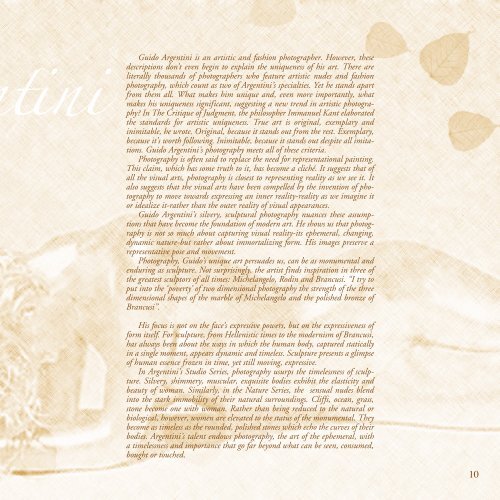Postromanticism The Art of Passion - Claudia Moscovici
Postromanticism The Art of Passion - Claudia Moscovici
Postromanticism The Art of Passion - Claudia Moscovici
Create successful ePaper yourself
Turn your PDF publications into a flip-book with our unique Google optimized e-Paper software.
tini<br />
Guido Argentini is an artistic and fashion photographer. However, these<br />
descriptions don’t even begin to explain the uniqueness <strong>of</strong> his art. <strong>The</strong>re are<br />
literally thousands <strong>of</strong> photographers who feature artistic nudes and fashion<br />
photography, which count as two <strong>of</strong> Argentini’s specialties. Yet he stands apart<br />
from them all. What makes him unique and, even more importantly, what<br />
makes his uniqueness significant, suggesting a new trend in artistic photography?<br />
In <strong>The</strong> Critique <strong>of</strong> Judgment, the philosopher Immanuel Kant elaborated<br />
the standards for artistic uniqueness. True art is original, exemplary and<br />
inimitable, he wrote. Original, because it stands out from the rest. Exemplary,<br />
because it’s worth following. Inimitable, because it stands out despite all imitations.<br />
Guido Argentini’s photography meets all <strong>of</strong> these criteria.<br />
Photography is <strong>of</strong>ten said to replace the need for representational painting.<br />
This claim, which has some truth to it, has become a cliché. It suggests that <strong>of</strong><br />
all the visual arts, photography is closest to representing reality as we see it. It<br />
also suggests that the visual arts have been compelled by the invention <strong>of</strong> photography<br />
to move towards expressing an inner reality-reality as we imagine it<br />
or idealize it-rather than the outer reality <strong>of</strong> visual appearances.<br />
Guido Argentini’s silvery, sculptural photography nuances these assumptions<br />
that have become the foundation <strong>of</strong> modern art. He shows us that photography<br />
is not so much about capturing visual reality-its ephemeral, changing,<br />
dynamic nature-but rather about immortalizing form. His images preserve a<br />
representative pose and movement.<br />
Photography, Guido’s unique art persuades us, can be as monumental and<br />
enduring as sculpture. Not surprisingly, the artist finds inspiration in three <strong>of</strong><br />
the greatest sculptors <strong>of</strong> all times: Michelangelo, Rodin and Brancusi. “I try to<br />
put into the ‘poverty’ <strong>of</strong> two dimensional photography the strength <strong>of</strong> the three<br />
dimensional shapes <strong>of</strong> the marble <strong>of</strong> Michelangelo and the polished bronze <strong>of</strong><br />
Brancusi”.<br />
His focus is not on the face’s expressive powers, but on the expressiveness <strong>of</strong><br />
form itself. For sculpture, from Hellenistic times to the modernism <strong>of</strong> Brancusi,<br />
has always been about the ways in which the human body, captured statically<br />
in a single moment, appears dynamic and timeless. Sculpture presents a glimpse<br />
<strong>of</strong> human essence frozen in time, yet still moving, expressive.<br />
In Argentini’s Studio Series, photography usurps the timelessness <strong>of</strong> sculpture.<br />
Silvery, shimmery, muscular, exquisite bodies exhibit the elasticity and<br />
beauty <strong>of</strong> woman. Similarly, in the Nature Series, the sensual nudes blend<br />
into the stark immobility <strong>of</strong> their natural surroundings. Cliffs, ocean, grass,<br />
stone become one with woman. Rather than being reduced to the natural or<br />
biological, however, women are elevated to the status <strong>of</strong> the monumental. <strong>The</strong>y<br />
become as timeless as the rounded, polished stones which echo the curves <strong>of</strong> their<br />
bodies. Argentini’s talent endows photography, the art <strong>of</strong> the ephemeral, with<br />
a timelessness and importance that go far beyond what can be seen, consumed,<br />
bought or touched.<br />
10


